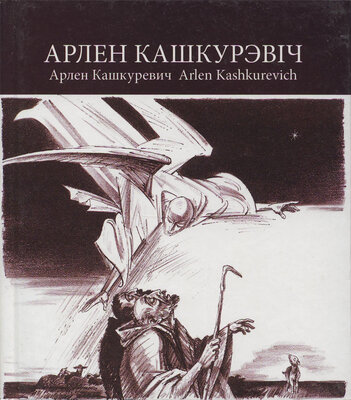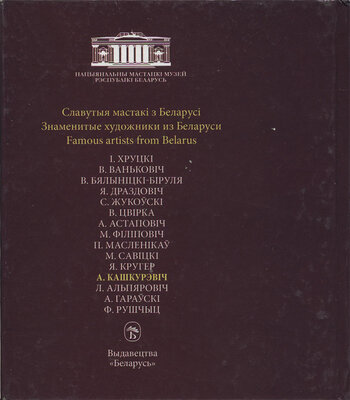Арлен Кашкурэвіч
Выдавец: Беларусь
Памер: 83с.
Мінск 2014
Для наших современников личность Арлена Кашкуревича, художника-интеллектуала, неотделима от его искусства, вызывающего признание и неподдельный интерес в обществе своей актуальностью, проблематичностью, драматизмом.
Константин Барабанов
urther away goes the twentieth century, the more evident becomes importance of a significant period of the Belarusian visual arts of the second half of the century. It was the beginning of the 1960s when the artistic life of the republic was enriched by new young creative power of the generation of artists who expressed their views of the modern world in their own way. At that stage the most radical changes happened in the art of graphics. Using of new artistic methods, applying of modern creative techniques, variety of subjects, complex compositional structures, introducing multi-temporal and multi-scale images to the work structure, active use of printmaking are the main artistic characteristics of the graphics masters of the new generation: Alyaksandra Paslyadovich, Georgy Paplausky, Ludvig Asetsky, Alena Los, etc.
In this cohort of the founders of modern art the special place belongs to Arlen Kashkurevich (15.09.1929—26.08.2013). Together with his allies he took an active part in the consolidation of modern aesthetic ideals, new themes and images, artistic devices and forms peculiar to the graphic arts. In his early works artist rejected illusory solutions of space emphasizing expressiveness of silhouettes on the sheet, he used figural and emotional opportunities of black and white contrast in linocut, beauty of lines and splashes of colour in lithography, rigorous expressive touches in etching and drypoint technique.
Arlen Mikhailavich Kashkurevich was born in September 15, 1929 in Minsk where he lived all his life excluding a short period of evacuation to Saratov during World War II. After the liberation of Belarus he returned to his native city. After graduation of a seven-year school he entered Minsk Civil
Engineering College. Showing extraordinary talent for drawing, he worked with enthusiasm in the studio of visual arts at Minsk House of Folk Art, which was led by an experienced teacher and great master of painting Mikalai Tarasikau. Soon Arlen Mikhailavich won admission to Minsk Art College from which he successfully graduated in 1953. The same year he decided to continue his education at the Graphics Department of the Belarusian State Theatre and Art Institute. There he was taught by such distinguished artists and pedagogues as Leu Leitman, Uladzimir Sukhaverkau, Pavel Lubamudrau, Vitaly Tsvirka and Siamen Gerus.
Already during his first years of education Arlen Kashkurevich published his drawings and illustrations to books in various periodicals. He proved himself well at the thesis work a series of illustrations to the novel Atom Station (1959) by the Icelandic writer Halldor Laxness. The illustrations were made in the colour lithography technique and soon were approved by the author himself.
After the graduation he was offered a post of a lecturer in the Institute and ten following years he dedicated to that work. In 1960, he was accepted to the Artists’ Union of the BSSR and the same year he became a constant participant of the republican and all-union exhibitions.
A significant place at the creative work of Arlen Kashkurevich was taken by book illustrating. Many years he dedicated to book decoration and fruitfully worked at the field of bookplate making. His works are not simply illustrations to a text or visual representation of a plot but deep penetration into the essence of a literary work, revealing of its philosophic and ethic contents. Artist’s illustrations are laconic and many layered at the same time. And it is always a fresh and original view of a thoughtful reader and real co-author of a writer.
Design of the book Three Poems (1962) by Yanka Kupala became one of the first prominent works at the master’s early period. Artistic language of the illustrations to the poems Barrow, Bandarouna, Lion’s Tomb stingy, severe and emotional at the same time coordinates well with the spirit of Kupala’s poetry.
Subtle understanding of the book architectonics enabled the artist to take an active part in the developing of its design. Illustrations of this unique limited edition were made from artists plates. The book was awarded the second degree diploma at the All-Union Competition in Moscow.
Thereafter, the work of Arlen Kashkurevich at books The Third Generation (1960) by Kuzma Chorny, Snowy Wintersand The Heart on the Open Palm (1966) by Ivan Shamiakin, The Gadfly (1968) by Ethel Lilian Voynich, King Stakhs Wild Hunt (1983) and Ears of Rye under Thy Sickle (1968) by Uladzimir Karatkevich, Fairytales (1984) by Hans Christian Andersen, Chasteners and The Khatyn Story (1974) by Ales Adamovich were frequently awarded with diplomas and awards for the best book design at the all-union and international contests.
A series of illustrations to The Song about Bison (1973) by Mikola Gusowski became a remarkable achievement of the artist. Slender expressive lines of drawings in the work resemble an ancient engraving. With such a technique Kashkurevich reached a full correspondence of visual design of sheets with the spirit of the epoch when this outstanding lyrical and epic poem had been created. The book was awarded a diploma and E Skaryna medal at the republican contest and a first degree diploma at the All-Union Contest in Moscow in 1974.
Among his colleagues Arlen Kashkurevich, who was an extremely educated person, was notable for deep comprehension of world art and western European art in particular. A special place in the context of European literary classics figurative interpretation belongs to a large series of Variations on a theme of “Faust” by Johann Wolfgang von Goethe (1975). A prevailing idea of the tragedy by the great German poet and thinker about human responsibility for his actions and the necessity of moral choice found its embodiment in allegorical images with their unusual interpretation of characters and events in the works of this epic cycle. Introducing such modern realities as American football players, contemporary military uniform of Apotheosis of War characters, naked witches riding motorcycles and up-to-date equipment of the
Faust’s laboratory make the perception of complex images with philosophical depth more acute.
Pain, grief and protest are dominant emotional accents of illustrations to the book Chasteners (1981—1982) by Ales Adamovich. The artist mercilessly analyzed and judged true inhumane essence of the Nazi ideology. Images of Ancient Roman, Eastern and modern dictators deepen and widen remarkably the conception of both the writer and the artist.
Easel painting principal is evident in a series of illustrations to the novel Blizzard Stop (1986) by Chinghiz Aitmanov. Endless steppe, cosmodrome, images of exotic characters are constituents of a single ensemble. Particularly expressive sheets are A Crossing Loop with an old newspaper rising in a gust of wind over a desolate steppe road crossing and the dynamic composition of The Taming of Karanar with the image of soulless and devoid of memory Mankurt.
With no less enthusiasm the artist worked in the genre of bookplate and miniature. He created dozens of bookplates, mainly in the technique of linocut, for publishing houses, public and private libraries. A small format of a bookplate assumes particular meticulousness in the technique, skill in the compositional solution of a small sheet and unobtrusive symbolism in the figurative embodiment of a design. Furthermore, it was necessary to consider the nature of a book collection, the social status and personality of a collection owner, his preference in the choice of books and hobbies. Full of warm humor miniatures with wise and witty Latin aphorisms are no less brilliantly executed.
A creative space of Kashkurevich had no limits. He was a wide range artist who had hold on pathos and exceptional dramatic nature of heroic events (Partisans, 1969—1970; Blockade, 1978), heartfelt lyricism of tenderly outlined female images (She and I, 1970), depiction of the beauty of creative work (Masters, 1966—1967), the problem of correlation between good and evil (Faust, 1975), terrifying grotesque (Napalm, 1985) and high poetry of Icelandic epos (Edda, 1993).
The artist paid much attention to the creation of large cycles of easel graphics works. Series of works helped him to reveal his idea in a more complete and varied way. The etching series Masters, dedicated to workers of Belarusian Glassworks Neman, is a true hymn to the inspired creative work. The hard work of glasswork masters was expressed with the help of edgy and stingy lines in the sheets Brigade, Glass Blower, Guta. Images of female workers were interpreted differently with the help of rounded soft lines (Inspiration, Cutters, Quality Control Department).
A small series of engravings Partisans was dedicated to the heroic deeds of the Great Patriotic War. No battle scenes are depicted on four graphic sheets made in the etching and drypoint technique, but nevertheless each work is pierced with the wartime tragedy. The theme of the exploit of the warrior people, the partisan people in the troubled wartime years is revealed in the expressive dynamics of the etching Thirst and the stern immobility of Partisan Mothers. It was the cycle of engravings Partisans and also the series of graphic sheets after the works of Yanka Kupala that brought the artist the BSSR State Prize in 1972. And in a year Arlen Kashkurevich was awarded the title of the Honoured Artist of the BSSR.
Vivid and memorable images of Arlen Kashkurevich amaze viewers with their emotional power. The master used flexible lines or expressive dynamics of spiny lines to characterize his wrathful or lyrical, heroic or elegiac works. The artist freely used a lot of technical methods taking into account their appropriateness in each particular case.
 КНІГІ ОНЛАЙН
КНІГІ ОНЛАЙН


